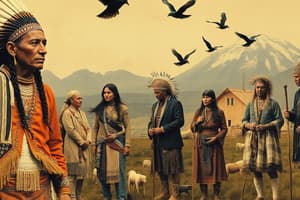Podcast
Questions and Answers
What is one of the factors that led to unique cultural expressions among Native American tribes?
What is one of the factors that led to unique cultural expressions among Native American tribes?
Which tribe turned weaving into a sophisticated art form according to the text?
Which tribe turned weaving into a sophisticated art form according to the text?
How did geography influence the cultural distinctions among Native American tribes?
How did geography influence the cultural distinctions among Native American tribes?
Which region's tribes celebrated special feasts when food was plentiful, according to the text?
Which region's tribes celebrated special feasts when food was plentiful, according to the text?
Signup and view all the answers
What is the significance of traditional dances like powwows in Native American communities?
What is the significance of traditional dances like powwows in Native American communities?
Signup and view all the answers
Which tribal societies commonly have a close relationship between land and spirituality?
Which tribal societies commonly have a close relationship between land and spirituality?
Signup and view all the answers
What is the purpose of the Sun Dance ceremony among Native American tribes?
What is the purpose of the Sun Dance ceremony among Native American tribes?
Signup and view all the answers
Which of the following is NOT mentioned as a tradition within Native American settlements?
Which of the following is NOT mentioned as a tradition within Native American settlements?
Signup and view all the answers
What do the categories Algonquian, Athabaskan, and Siouan refer to in relation to Native American languages?
What do the categories Algonquian, Athabaskan, and Siouan refer to in relation to Native American languages?
Signup and view all the answers
Which tribe speaks an Algonquin dialect according to the text?
Which tribe speaks an Algonquin dialect according to the text?
Signup and view all the answers
Why might neighboring tribes speak different languages despite sharing similar cultural traits?
Why might neighboring tribes speak different languages despite sharing similar cultural traits?
Signup and view all the answers
What aspect of Native American societies is highlighted as intriguingly complicated yet enlightening in the text?
What aspect of Native American societies is highlighted as intriguingly complicated yet enlightening in the text?
Signup and view all the answers
Study Notes
Indian tribes have been part of American history since before it began, with their cultures, traditions, and languages being some of the most unique aspects of early society. They were diverse groups of people who lived throughout North America, each having distinct customs and beliefs. Here's what you need to know about these cultural distinctions among Native Americans:
Culture
The various tribes had different ways of living depending on where they settled. Some tribes, like those in Greenland, celebrated special feasts when food was plentiful. Others, such as those in Virginia and Maryland, created art from copper, stone, wood, or animal bone. These cultural differences come down to geography and resources available within specific regions, leading to unique expressions through dance, song, craftwork, etc. For example, the Hopi Indians made weaving into a sophisticated art form, while the Eskimo peoples developed complex fishing methods due to their seafood dietary habits. Each tribe also had its own spiritual practices, often connected closely to nature and seasonal changes. This close relationship between land and spirituality is common across many tribal societies.
Traditions
Traditional dances played an important role in the lives of many Indian tribes. A well-known traditional dance is called the powwow which involves men and women dancing together. These dances have ancient roots and hold deep significance in the communities that perform them. Another tradition found among several tribes is a custom known as the Sun Dance ceremony where participants take part in rituals meant to improve health and bring good luck. Additionally, there are warrior traditions, marriages under certain rules, religious leaders called medicine men or wise ones, and songs sung by individuals according to their social standing. All these varied traditions gave structure to daily life within native settlements along with providing continuity beyond generations.
Languages
Native American languages fall into three major categories - Algonquian, Athabaskan, Siouan - reflecting linguistic groupings based upon common ancestry. For instance, Dakota Indians speak an Algonquin dialect, whereas Navajo speaks a branch related to Apache. There are numerous other examples too. While all members of one tribe spoke the same tongue, neighboring tribes might speak different languages even if they shared similar cultural traits!
In summary, understanding Indian tribes means getting familiar with their individual histories, traditions, and lifestyles, including the nuanced variations seen in their arts, rites, foods, dress, games, music, and speech. It is precisely this diversity - culturally speaking - that makes studying Native American societies so intriguingly complicated yet enlightening.
Studying That Suits You
Use AI to generate personalized quizzes and flashcards to suit your learning preferences.
Description
Explore the cultural distinctions among Native American tribes, including their ways of living, traditional dances, important ceremonies, and diverse languages. Learn about the unique expressions through dance, song, craftwork, and how each tribe had its own spiritual practices closely connected to nature. Gain insights into the linguistic groupings based on common ancestry and the rich tapestry of histories, traditions, and lifestyles across different tribes.




